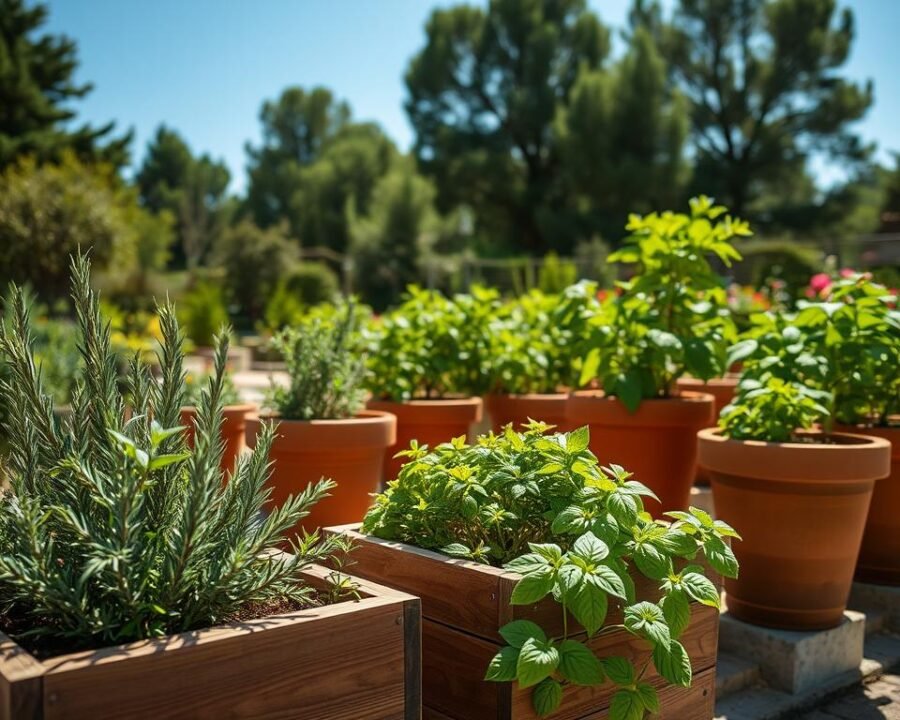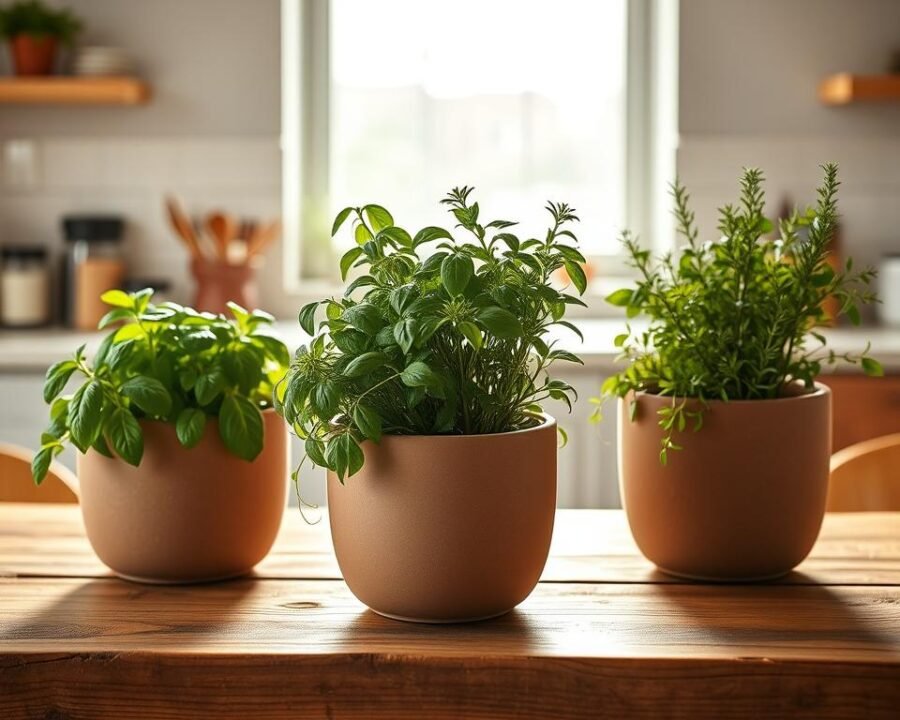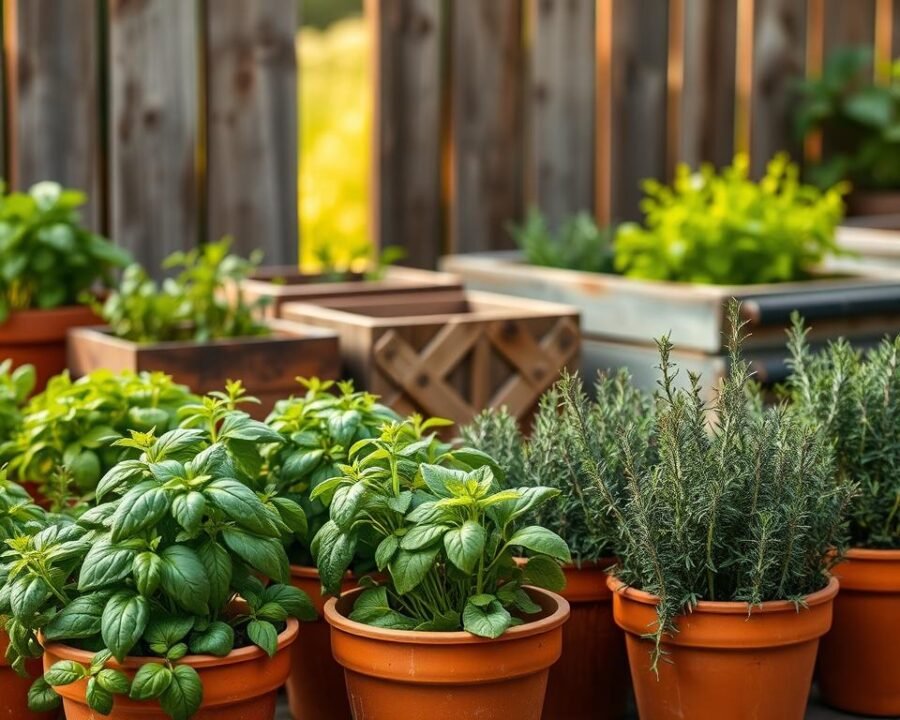There’s something special about stepping outside and snipping fresh herbs for dinner. No more wilted store-bought bundles—just vibrant flavors grown right at home. Whether on a sunny balcony or a cozy kitchen counter, growing your own greens has never been easier.
Modern planters bring convenience to small spaces. Self-watering designs, vertical stacks, and compact setups let anyone cultivate fresh ingredients year-round. Even beginners can succeed with the right tools.
From the AeroGarden Harvest Elite to space-saving vertical options, this guide covers top-rated choices. We’ll help you find the perfect match for mint, basil, or thyme—no grocery runs required.
Key Takeaways
- Fresh herbs thrive in compact spaces with the right planters.
- Self-watering systems simplify maintenance for busy lifestyles.
- Vertical designs maximize small balconies or patios.
- Options like the AeroGarden Harvest Elite suit beginners and experts.
- Growing at home cuts costs and boosts flavor in meals.
Why Herb Garden Planters Are a Must-Have for Every Gardener
Nothing beats the aroma of freshly picked greens right from your living space. With modern setups, cultivating fresh herbs becomes a rewarding ritual—no backyard required.
The Joy of Growing Fresh Herbs at Home
Snipping homegrown basil or thyme sparks pride and saves money. A $40 planter yields endless harvests, while store-bought packets cost $3 each—and lack vibrancy.
One gardener shared: “Watching chives thrive indoors through winter built my confidence.” Freezing parsley extends freshness, making year-round flavor super easy.
How Planters Simplify Herb Cultivation
Vertical designs, like the Amazing Creation stack, maximize balconies. For invasive herbs like mint, contained pots prevent garden takeovers.
Self-watering systems (e.g., Lettuce Grow) cut daily chores. The iDOO kit handles 12 pods, while Gardyn fits 30 plants—ideal for many herbs.
Hydroponic options, such as AeroGarden, grow greens six times faster than soil. Whether it’s thyme’s 50+ varieties or compact parsley, the right planter adapts to any space.
Key Features to Look for in Herb Garden Planters
Healthy roots start with thoughtful planter selection. The right design prevents common pitfalls like rot or cramped growth. Focus on these three features to keep greens vibrant.
Drainage Holes: A Non-Negotiable for Healthy Herbs
Without drainage holes, excess water drowns roots. The Barnyard Designs planter uses a built-in system to avoid sogginess. Soak and dry cycles mimic natural conditions, reducing rot risks.
Size and Space: Matching Planters to Your Herbs’ Needs
Basil thrives in 10-inch depths, while thyme fits 6-inch pots. Perennial herbs like rosemary need room for robust roots. The Gardyn Home Kit 3.0 offers 30 slots—ideal for varied sizes.
Material Matters: From Ceramic to Self-Watering Systems
Ceramic insulates roots but weighs more. Plastic is lightweight, like the Click & Grow’s 3-pod design. For hands-off care, the Lettuce Grow Farmstand uses self-watering tech with moisture sensors.
| Material | Pros | Cons |
|---|---|---|
| Ceramic | Insulates roots, stylish | Heavy, fragile |
| Plastic | Lightweight, affordable | Less breathable |
| Self-Watering | Low-maintenance | Higher cost |
Transplant crowded plants early, as overcrowding stunts growth. Whether it’s a windowsill pot or a vertical stack, prioritize features that match your greens’ needs.
Best Indoor Herb Garden Planters for Year-Round Freshness
Indoor herb setups bring restaurant-quality flavors to any kitchen. With the right planter, fresh herbs thrive regardless of outdoor space. These systems fit seamlessly near windows or under grow lights, delivering vibrant greens even in winter.
AeroGarden Harvest Elite: Perfect for Beginners
The AeroGarden Harvest Elite simplifies growing with automated care. Its LED lights and nutrient reminders make it super easy for first-timers. Testers report basil yields doubling compared to soil, thanks to 6x faster growth rates.
Watch for light burn—adjustable arms prevent leaf damage. The Grow Anything kits expand options beyond pre-seeded pods. At a 45% discount, it’s a cost-effective entry into hydroponics.
Click and Grow Smart Garden 3: Compact and Efficient
With an 8.25″ depth, this sleek unit fits tight spaces like apartment counters. The built-in LED spectrum mimics sunlight, ideal for kitchens lacking natural light. One user noted: “My thyme grew bushier than in outdoor pots.”
| Feature | AeroGarden Harvest Elite | Click & Grow Smart Garden 3 |
|---|---|---|
| Growth Speed | 6x faster than soil | 3x faster than soil |
| Space Needed | 12″ width | 8.25″ depth |
| Special Tech | Nutrient reminders | Adjustable lamp arms |
Pair either with inbloom’s red light tech to boost leaf density. For pesticide-free herbs, start with organic seed pods. A $100 iDOO kit pays off long-term, replacing $40 mason jar setups.
Top Outdoor Herb Garden Planters for Sunny Spaces
Sunlight transforms outdoor spaces into thriving hubs for flavorful greens. Whether on a breezy balcony or a sunny patio, the right containers turn small areas into lush herb havens. Durable materials and smart designs handle wind, heat, and growth needs effortlessly.

Barnyard Designs Herb Pot Planter Set: Stylish and Functional
With over 3,000 Amazon reviews, Barnyard Designs’ set blends farmhouse charm with practicality. The included drainage tray prevents root rot—a must for healthy plants. UV-resistant ceramic withstands summer rays without fading.
One gardener noted: “The 20% discount made this set a steal for my rosemary and oregano.” Pair thyme with sweet alyssum in the same pot for pest control and visual appeal.
Vertical Garden Planters: Maximize Small Spaces
Tower designs like Amazing Creation’s 15-plant system save square footage. Compared to Lettuce Grow’s Farmstand, it offers tighter spacing for compact garden spots. Both feature wind-resistant frames, crucial for breezy balconies.
| Feature | Amazing Creation | Lettuce Grow |
|---|---|---|
| Capacity | 15 plants | 12 plants |
| Material | Plastic (UV-treated) | Steel frame |
| Best For | Mediterranean herbs | Leafy varieties |
Rosemary thrives in vertical setups—use skewers to train stems upward. For wilted parsley, revive it with afternoon shade and deep watering. Outdoor success starts with matching drainage holes and sunlight to each herb’s needs.
Best DIY Herb Garden Planters for Creative Gardeners
DIY projects turn everyday items into thriving green spaces. From mason jars to upcycled crates, personalized setups add charm while cutting costs. Whether for a sunny windowsill or a tiny balcony, these ideas make growing herbs accessible and fun.
The Sill Garden Jar Duo: Simple and Chic
The Sill’s reusable jars feature a wicking system for consistent water delivery. At an 87% discount, the $40 set includes organic basil seeds. One user shared: “My chives flourished—no overwatering worries.”
Pair these with inbloom’s hydroponic sponges for soil-free growth. The sleek design suits modern kitchens, while the built-in tray prevents leaks.
Mason Jar Herb Gardens: Budget-Friendly and Versatile
For under $15, mason jars offer endless customization. Drill 1/4-inch holes in lids for drainage, then layer pebbles and soil. Freeze excess basil as pesto cubes—perfect for winter use.
| Option | Cost | Best For |
|---|---|---|
| The Sill Jar Duo | $40 | Beginner-friendly care |
| DIY Mason Jars | $15 | Upcycling enthusiasts |
Upcycle tin cans or vintage crates for rustic appeal. Companion planting—like parsley with marigolds—deters pests naturally. Ensure jars have 2-inch gaps for air circulation to prevent mold.
“Sharing cuttings with neighbors built our community herb exchange.”
For windy areas, secure jars with twine or adhesive strips. Whether using The Sill’s polished look or handmade pots, creativity grows the tastiest results.
Self-Watering Herb Planters for Low-Maintenance Gardening
Busy lifestyles demand gardening solutions that work on autopilot. Self-watering systems eliminate guesswork, delivering just the right amount of water to keep herbs vibrant. Whether you’re traveling or juggling work, these setups ensure plants never go thirsty.

Lettuce Grow Farmstand: Ideal for Busy Plant Parents
The Farmstand’s 9-gallon tank sustains herbs for up to two weeks—perfect for vacations. Its app monitors moisture levels, adjusting delivery automatically. One user raved: “My basil stayed perky during a 10-day trip.”
- Super easy setup with pre-sprouted seedlings.
- Quiet pump system (under 25 dB) for noise-sensitive spaces.
- Pair with Veritable’s auto-leveling tech for uneven surfaces.
iDOO Indoor Herb Garden Kit: Set It and Forget It
With a clear water-level window, the iDOO kit removes overwatering worries. Choose from mint-green or white to match your garden decor. Monthly liquid plant food (included) simplifies care.
| Feature | Lettuce Grow | iDOO |
|---|---|---|
| Reservoir Size | 9 gallons | 1.5 gallons |
| Tech | App-controlled | Manual refill |
| Best For | Large herb collections | Small kitchens |
Pro tip: Use distilled water to prevent mineral buildup. For mold prevention, ensure airflow around roots. These systems turn hectic schedules into lush, thriving spaces effortlessly.
Herb Planters with Built-In Grow Lights
Built-in grow lights revolutionize how we nurture plants indoors. These systems mimic natural sunlight, allowing herbs to flourish regardless of window access or season. From compact countertop units to vertical farms, lighting technology makes professional results achievable at home.
Gardyn Home Kit 3.0: High-Tech for Optimal Growth
With space for 30 herbs, this $695 system includes a camera for remote monitoring. The adjustable LED arms accommodate mature roots, while companion app alerts prevent overgrowth. One urban gardener reported: “My bok choy yielded three harvests before my outdoor plot produced one.”
Key advantages over traditional setups:
- Full-spectrum lights enhance essential oil production (per second source data)
- 12-hour daily operation costs ≈$8/month—cheaper than store-bought organic food
- Pairs with Click & Grow’s timer for automated dawn/dusk cycles
inbloom Hydroponics System: Sleek and Effective
Red light technology in this unit boosts leaf density by 40% compared to standard LEDs. All components are dishwasher-safe, simplifying cleanup between plantings. The third source confirmed its effectiveness for Mediterranean varieties like rosemary and thyme.
| Feature | Gardyn 3.0 | inbloom |
|---|---|---|
| Light Type | Full spectrum | Red-enhanced |
| Daily Energy Use | 0.5 kWh | 0.3 kWh |
| Ideal For | Large garden setups | Compact kitchens |
Morning sun lovers may need supplemental lighting. The inbloom’s modular design lets you expand as your herb collection grows. Both systems eliminate soil mess while delivering vibrant flavors straight to your plate.
Best Herb Planters for Small Spaces
Small spaces shouldn’t limit your ability to grow flavorful greens. With clever designs, even a 6.1″ windowsill or narrow balcony can host thriving plants. Vertical stacks and magnetic pots turn unused areas into lush, productive spots.
Amazing Creation Vertical Planter: Balcony Savior
This 15-slot system fits rosemary, thyme, and parsley without hogging much space. The third source confirms its UV-treated plastic withstands outdoor conditions. For railings, ensure weight stays under 20 lbs—pair lightweight pots like Barnyard’s 4.25″ ceramic set.
One urban gardener shared: “Tiered designs let me grow basil upstairs and mint below—no sprawl.” Companion planting (e.g., thyme with marigolds) doubles yields while deterring pests.
Windowsill Solutions: Compact and Efficient
Single-row boxes suit dwarf basil varieties, while Click & Grow’s 3-pod kit thrives under cabinets. Magnetic planters stick to fridge sides—ideal for chives. The second source notes parsley’s shallow roots excel in 6″-deep setups.
| Option | Capacity | Best For |
|---|---|---|
| Amazing Creation | 15 plants | Sun-loving herbs |
| Windowsill Box | 3–5 plants | Microgreens or thyme |
Pro tip: Rotate plants weekly for even light exposure. With these space-savers, fresh flavors are always within reach.
Herb-Specific Planter Tips
Each herb thrives under specific conditions, demanding tailored planter solutions. From basil’s deep-rooted needs to mint’s invasive tendencies, matching containers to growth habits ensures vibrant, healthy plants.
Basil: Deep Pots for Robust Roots
Basil’s roots grow vigorously, requiring 12-inch depths for maturity. The second source confirms its 6-hour sunlight minimum—pair deep pots with sunny spots. For hydroponics, Lettuce Grow’s tubes accommodate long root systems.
Prevent overcrowding by spacing plants 6 inches apart. One gardener noted: “My Genovese basil doubled in size after transplanting to a deeper planter.”
Mint: Contained Planters to Prevent Invasion
Mint’s aggressive roots spread rapidly. Use metal or thick plastic barriers to curb expansion. Chocolate mint (per second source) thrives in 8-inch-wide containers—ideal for small spaces.
Key comparisons for other herbs:
- Rosemary: Woody roots need breathable soil (e.g., clay pots).
- Parsley: Fine roots suit shallow trays with frequent water.
- Thyme: Drought-resistant; sandy mixes prevent rot (third source).
“Dividing mint roots annually keeps it manageable.”
| Herb | Pot Depth | Special Requirement |
|---|---|---|
| Oregano | 6″ | Shallow, wide trays |
| Chives | 8″ | Moisture-retentive soil |
For herbs like sage, the Farmstand’s root separation tech prevents tangling. Whether curbing mint or nurturing basil, the right planter transforms challenges into lush harvests.
How to Choose the Right Planter for Your Herbs
Selecting the perfect container makes all the difference in growing vibrant, flavorful greens. The right planter accommodates root systems, balances moisture, and matches light conditions—key factors for thriving plants.

Match Planter Size to Growth Habits
Deep-rooted varieties like parsley need 12-inch depths, while thyme flourishes in 6-inch pots. Mediterranean herbs (rosemary, oregano) prefer breathable terracotta, whereas moisture-loving basil thrives in glazed ceramic.
- Shallow containers (4–6″): Ideal for chives, thyme, or dwarf basil
- Medium pots (8–10″): Fits most varieties, including mint (with barriers)
- Deep planters (12″+): Best for lemongrass or parsley’s taproots
For multi-herb setups, space-efficient designs prevent overcrowding. The third source’s Farmstand Glow Rings help separate roots in shared planters.
Factor in Light and Water Needs
South-facing windows suit sun-loving varieties, while UV meters help gauge intensity for indoor setups. The second source notes thyme’s “dry feet” preference—avoid overwatering with terracotta’s natural wicking.
| Herb Type | Light Needs | Pot Material |
|---|---|---|
| Basil | 6+ hours sun | Glazed ceramic |
| Rosemary | Full sun | Terracotta |
| Parsley | Partial shade | Self-watering plastic |
Gardyn’s app-controlled environments adjust light schedules automatically. For humid climates, Veritable’s preset cycles prevent mold in moisture-sensitive herbs like lavender.
“Grouping herbs by similar water needs simplified my care routine.”
Start small with 3–5 plants, then expand gradually as the first source suggests. Whether using stacked planters or individual pots, align choices with each herb’s natural habitat for best results.
Maintaining Your Herb Garden Planters
Smart routines transform herb cultivation from chore to effortless habit. Whether using hydroponics or soil, consistent care ensures robust growth and flavorful harvests. Tailor these practices to your setup for year-round freshness.
Watering and Feeding Schedules
AeroGarden’s liquid nutrients work best every two weeks, while soil-based plants thrive with monthly organic feeds. Synthetic options yield faster growth but may alter taste.
- Hydroponic systems: iDOO’s reminders simplify nutrient timing.
- Soil planters: Use compost tea for slow-release nourishment.
- Water pH: Keep between 6.0–7.0 (per third source data).
Overwatering risks mold—space herbs 4–6 inches apart for airflow. The Gardyn app suggests adjustments based on real-time root health scans.
Seasonal Care Tips
Winter dormancy affects rosemary and thyme. Move pots indoors or use grow lights for 12-hour cycles. Hardening-off plants in spring prevents shock (second source).
| Season | Task | Tool |
|---|---|---|
| Summer | Prune leggy stems | Micro-tip shears |
| Fall | Divide mint roots | Garden fork |
“Reviving wilted basil with a 30-minute soak saved my summer harvest.”
For frost-prone areas, wrap outdoor garden pots in burlap. Track time-sensitive tasks like parsley’s biennial replanting for uninterrupted yields.
Conclusion
Fresh flavors at home start with the right setup. Growing your own herbs slashes grocery bills—just one AeroGarden pays for itself in basil harvests.
Pet owners love separating catnip from mint. DIY mason jars make heartfelt gifts, especially with third-source discount codes.
Mix indoor and outdoor systems for year-round yields. Try the first source’s kitchen mission or the second’s herb salt recipe.
Skip pesticides and share cuttings with neighbors. Every snip brings us closer to sustainable, vibrant meals.
